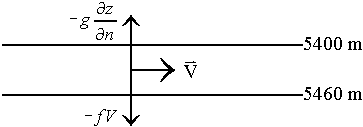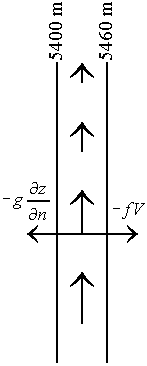

Geostrophic flow in the atmosphere is the most applied balanced flow among the five that are defined. Specifically, the geostrophic assumption assumes that there is a balance between the following forces in the n equation of motion:
The coriolis force: 
 The pressure gradient force:
The pressure gradient force: 
A large portion of meteorological forecast computer models use the geostrophic assumption when forecasting wind derived products in the upper atmosphere, such as vorticity and divergence. The geostrophic assumption is good to use in areas where the flow is straight and frictionless, such as in the upper atmosphere. This assumption does not work when the amount of curvature is large in the upper atmosphere, since curvature will allow the centrifugal force in the momentum equation to have a more substantial magnitude. Although, the Gradient wind equation does correct for curvature in the flow by incorporating all of the terms in the n equation of motion. Although the geostrophic wind is not a perfect assumption to make, it does save computational time and simplifies some of the complicated dynamical equations.
The following picture shows how the forces balance out in geostrophic flow at 500mb in the northern hemisphere. Imagine the flow is moving from west to east, thereby not changing latitude.

Notice that the flow is parallel to the lines of constant geopotential height, as they should be by the definition of the geostrophic wind equation. To reiterate, since there is no friction, there is no cross-contour flow, and therefore, no acceleration of the flow.
The next picture will show geostrophic flow at 500mb that is moving from south to north.

Notice that the flow decelerates with time as the flow moves from south to north. This is because of the increase in the magnitude of the coriolis force as air parcels move towards the north. At first, this deceleration of the flow appears to violate the steady state condition of balanced flows. Fortunately, this is not the case. If the total tangential acceleration term is expanded, the answer becomes apparent:

where:

 = 0
= 0 
 = 0
= 0 
 = --
= -- 
 = 0
= 0 
 = ++
= ++
Although there is horizontal deceleration occurring, it is being counteracted by the acceleration of the vertical component of the wind. This implies that, in fact, the total tangential acceleration is zero, satisfying the steady state condition of balanced flows.
 Next topic: Gradient flow
Next topic: Gradient flow
 Previous topic: Cyclostrophic flow
Previous topic: Cyclostrophic flow